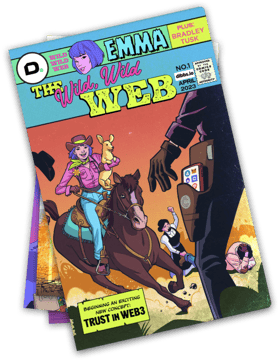How to Create a Physical-Backed Item Token
Item tokens are NFTs that represent physical items on a blockchain. Learn how brands can create item tokens and benefit from them.

In a world where NFTs (non-fungible tokens) have ignited the imagination of creators and collectors alike, one particular avenue stands out: physical-backed digital collectibles, also known as item tokens. Beyond the hype surrounding NFTs, these tokens bridge the tangible and digital realms, offering a captivating fusion of ownership, transparency, and authenticity. But how does one bring a physical collectible into the vibrant world of blockchain in a way that the digital counterparts effectively portray the physical items?
Subscribe to get our best content in your inbox
By clicking “Submit” you agree to Dibbs
Privacy Policy and
consent to Dibbs using your contact data for newsletter purposes.

This article unveils the process behind translating real-world treasures into item tokens—a fundamental pillar of the booming NFT market. We’ll also explore the creation of item tokens and discover how businesses can harness their potential for an immersive and enriching customer experience.
What is an Item Token?
Item tokens are digital assets that can immutably represent the ownership of a physical or digital asset on the blockchain. These digital assets redefine the way we engage with valuable possessions. In some cases, multiple parties can also hold a single item token with little room for dispute, offering an optimal solution for transparent fractional ownership.
Moreover, brands are already in action with GAP and Adidas using NFTs to earmark their exclusive goods. The growing number of brands exploring NFTs only amplifies the urgency for businesses to understand the process of creating item tokens and utilizing them.
How Physical-Backed Item Tokens Differ From Other NFTs
As the name suggests, physical-backed item tokens are linked to a corresponding physical item and serve as a digital certificate of ownership for that specific item. Traditional NFTs, however, exist virtually, involving no physical element. While this augurs well for a wide array of digital use cases, it fails to bridge the virtual world with the physical world. Beyond that, let’s check out the two factors that draw a clear distinction between item tokens and traditional NFTs.
Tangible Value
Physical-backed item tokens derive their value from a physical asset — be it a piece of land or a CryptoPunk pendant worth $50,000. This makes the value of item tokens more reliable for collectors and investors.
Contrarily, traditional NFTs derive their value from a combination of scarcity and uniqueness only. However, it all boils down to the market’s perceived worth of the NFT and its demand, which might simply be an extension of the greater fool theory.
Authenticity
The ability to physically verify the authenticity of a token amplifies the security of the physical object and reduces tampering risks. Methods like RFID (Radio Frequency Identification) tags further secure the bridge between the physical object and the item token. Traditional NFTs, however, are more complex to verify and authenticate. Currently, the time and resources needed to authenticate an NFT easily outweigh the benefits offered by an NFT for a layperson.
Now that we’ve established the differences between physical-backed item tokens and traditional NFTs, let’s see how brands and businesses can use them.
How Will Item Tokens Benefit My Business?
As businesses navigate the ever-changing digital landscape, finding innovative ways to gain a competitive edge becomes paramount. So, let’s delve into the transformative potential of item tokens and explore how they can specifically benefit your business.
Representation of Various Assets
Item tokens can represent any physical asset and have a single source of truth of ownership. For businesses and brands, item tokens are a solution bundle of sorts. Imagine Marvel minting their movie premiere tickets as item tokens and, as a thank you, offering limited-edition merchandise to be redeemed against those item tokens.
Transferability and Trading
The idea of global trading is going to finally realize its true potential with item tokens that bridge physical assets and virtual presence. Traditional geographical limitations fade away allowing brands to have a presence everywhere. Also, the facet of trading item tokens will create secondary marketplaces further building the NFT market.
Market Creation and Economies
Item tokens are set to disrupt the way we interact with real-world items in our daily lives. For example, a new watch brand can raise crowdfunding while issuing item tokens to each participant. Once the brand starts manufacturing, item token holders can avail of exclusive benefits.
Economies like secondary marketplaces, crowdfunding, and fractional investing are possible with item tokens.
A Step-by-Step Guide to Creating an Item Token
Now that you know what benefits item tokens can offer your business, let’s check out a brief step-by-step guide to creating a physical-backed item token.
Step 1: Capture a photorealistic digital version of the physical item.
To minimize the divide between the physical and the real world, the item token should represent the physical item as closely as possible to make a user’s experience immersive and realistic. However, you can, of course, let your creativity flow as item tokens can look however a creator wants them to.
Capturing physical items and developing a photorealistic digital version is a technical challenge currently, courtesy of a lack of tooling support. Yet, it’s a challenge that’s rarely discussed.
While the need for equipment is well-known, the need for expertise in capturing physical objects is a different game altogether. From consistent lighting to expert detailing, achieving a photorealistic digital version is not a simple task. It takes skill, knowledge, and practice.
That’s where Dibbs’ expertise helps brands with its tokenizing physical items and converting them into the perfect set of item tokens.
Step 2: Process the photo by 3D scanning and photo editing.
Tools like 3D scanning and editing software play a major role in polishing item tokens to be a hyperrealistic digital version of the physical items.
Step 3: Choose a blockchain.
You do not want your business or customers to be paying hundreds of dollars in gas fees or waiting hours for transaction completion. That’s why choosing the right blockchain is extremely important to mint your item tokens and offer a smooth user experience.
Step 4: Generate a smart contract tailored to your needs.
If you want your item tokens to hold specific functionality, say fractional ownership, you can code and publish a smart contract to append that into your tokens.
Step 5: Mint and market the tokens.
Once you’ve created the digital version of the physical item, chosen a blockchain, and defined its functionalities, you can publish the tokens on-chain and market them to your customers.
These steps are the simplest way to translate a physical item into an item token.
To learn more about asset tokenization, you can check out this blog.
Challenges of Using Item Tokens
Despite all their benefits, there are certain challenges that come with item tokens. Here are a few prominent ones:
Early-stage Technology
NFTs and blockchain are still a new technology. Hence, item tokens come with the general issues that any new and cutting-edge technology faces (e.g., lack of developer tooling, patchy infrastructure, and unrefined user experience).
Lack of Regulatory Clarity
Crypto, web3, and NFTs are fairly new technologies. That’s why, legal frameworks around item tokens, or NFTs, are still not well-defined across most jurisdictions. However, as major brands enter NFTs, regulators are taking note of the impact of NFTs and working alongside tech innovators to define laws that do not disrupt technological innovation.
Lack of Tokenization Support
Tokenization support for minting, marketing, and selling item tokens is currently scarce. The need to build from scratch deters brands big and small from venturing into asset tokenization.
Despite the challenges, item tokens are surely worth keeping tabs on as they have the potential to build new economies while upgrading the traditional ones. For this, identifying a good tokenization partner is key.

Evan Vandenberg
Evan Vandenberg is the Co-Founder and CEO at Dibbs. Evan has been working in the NFT space full-time since 2018 and collecting since 1995.

